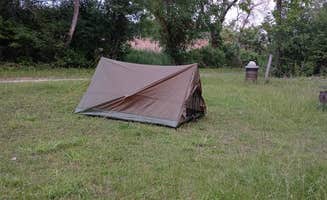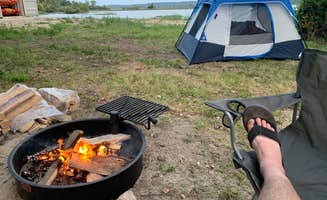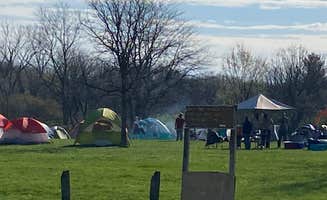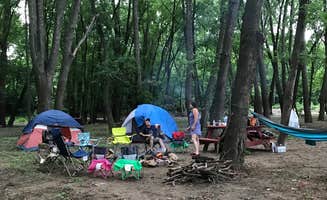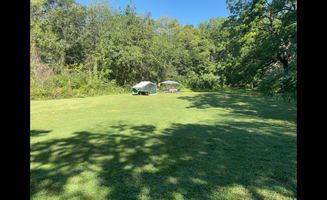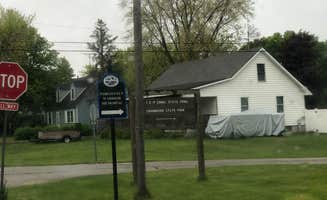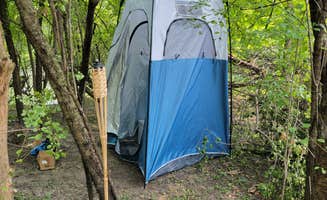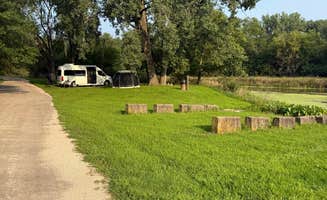Most primitive tent campsites near Ottawa, Illinois cluster along waterways. Elevation ranges between 450-500 feet along the Illinois River valley, with summer highs typically reaching 85°F and winter lows averaging 16°F. Flooding can occur during spring and early summer at several waterfront locations, with some sites requiring walks from parking areas.
What to do
Trail access from campgrounds: Buffalo Rock State Park Campground sites connect directly to the I&M Canal Tow Path. "The furthest site (the group site) is three miles from the ranger station. There are four sites total," explains one camper at Buffalo Rock State Park Campground.
Kayaking on multiple waterways: Kayak launches exist at several sites allowing access to the Illinois River. At Kayak Morris, "Between me and my buddies we caught over 50 striper. I don't know if its the river convergence or the lake but they bite here hard!" reports one visitor.
Winter camping options: Most campgrounds in the area operate seasonally, but McKinley Woods: Frederick's Grove offers year-round accessibility. "At night, you can hear owls and distant trains, but motorboats and jet-skis begin around 6:AM," notes a camper describing the early morning soundscape.
Bicycle touring stops: The I&M Canal Trail provides excellent biking opportunities with campgrounds serving as overnight points. A visitor to Channahon State Park Campground noted, "This campground is right in town. It is a bit away from businesses. However if you arrive by car you drive through the quaint town. Arriving by bicycle is even better."
What campers like
Riverside viewing spots: Many campers value the direct water access at several sites. At Kayak Starved Rock Campground, "Our campsite was wonderful and was on a point on the river that has a 180 degree view of the river," shared one reviewer.
Well-maintained pit toilets: Surprisingly, many campers positively mention the cleanliness of vault toilets. "The Porta potties were shockingly clean! The potties also have motion sensor lights in them for at night visits. They also have wipes, spray underarm deodorant, hand sanitizer and automatic air freshener," one Kayak Starved Rock camper reported.
Wildlife viewing opportunities: From river wildlife to birds, camping areas offer good animal spotting. A visitor to Buffalo Rock noted, "Also, there are buffalo and that's pretty cool," referring to the preserve's resident bison herd.
First-come camping flexibility: Hennepin Canal locations offer no-reservation camping. "The Canal's site security officer makes rounds to each campsite to collect camping fees, in-person. Campers can pay by cash or check," explains a visitor to Hennepin Canal Lock 11.
What you should know
Water supply limitations: Most locations have no reliable drinking water. At Hennepin Canal Lock 21, a reviewer advises, "There is no potable drinking water anywhere at any of these locks up and down the Hennepin Canal apart from at the Visitors Center, so ensure you bring your own water or a filtration system."
Site spacing concerns: Proximity between campsites varies greatly between locations. "The biggest thing we disliked about this place is how close the campsites are to one another. With a tent at every site, you're almost right on top of the next site, enough to clearly hear the person snoring two tents over," noted one Kayak Starved Rock camper.
Flood risk assessment: Low-lying sites may experience flooding after heavy rain. A visitor to McKinley Woods warned, "Our night went from on and off light rain to three hours of down pour rain. With that said our site was flooded once we woke up. We had three inches up the the fire pit."
Limited amenities at primitive sites: Many locations offer only basic facilities. "The canal offers class 'C' (primitive camping without showers or electricity) for $8.00 per family/per night, regardless of mode of camping, i.e. tent, camper, pop-up," explains a Hennepin Canal reviewer.
Tips for camping with families
Youth-specific camping areas: Starved Rock State Park - Youth Campground provides dedicated space for organized groups. "If you are here with your girl/boy scout troop, church group or youth connection team, then you've just discovered a super amazing spot to lay down some tents," explains one visitor.
Site selection strategy: Choose locations with proper facilities for children. At Kayak Starved Rock, "If you forget anything it's also a short drive to either Ottawa or Utica for staples," notes a camper, highlighting the convenience of nearby supply options.
Equipment considerations: Bring filtration for locations without reliable water sources. A Hennepin Canal Lock 21 camper mentioned, "The campsites are all on grassy areas with trees at the edges. This gives you some shade depending on the time of day."
Activity planning: Incorporate river activities for family engagement. "We brought our own kayaks and launched right from our campsite which was amazing but they rent kayaks for pretty cheap If you don't have your own," shared a Kayak Morris visitor.
Tips from RVers
Size restrictions: Most locations cater primarily to tent camping with limited RV access. At Hennepin Canal Lock 21 Campground, "No hook-ups, just grass with a fire pit and table. Water available a couple of places along the canal... We saw a class A, so they do fit," noted one RVer.
Launch access considerations: RVers with boats should note specific access points. "There's a confluence across the river which is great to float on," mentions a Kayak Morris visitor regarding water recreation opportunities.
Alternative parking options: Some sites require walking from parking areas. At Buffalo Rock, "Camp sites aren't actually in buffalo rock, they're across the street at I&M canal. You have to walk a bit to get there but the sites are great."
Off-season advantages: Less competition for spaces exists during shoulder seasons. A Hennepin Canal Lock 21 visitor noted, "Fee is $8 however if you're an Illinois resident over 62 camping is free Sunday through Thursday nights."


